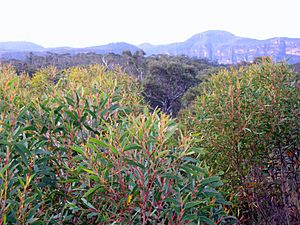Cliff mallee ash facts for kids
Quick facts for kids Cliff mallee ash |
|
|---|---|
 |
|
| Cliff mallee ash with the Grose Valley in the background, in the Blue Mountains | |
| Scientific classification | |
| Genus: |
Eucalyptus
|
| Species: |
cunninghamii
|
| Synonyms | |
|
|
The Cliff mallee ash, officially known as Eucalyptus cunninghamii, is a special type of eucalyptus tree. It grows only in the Blue Mountains of New South Wales, Australia. It's called "cliff mallee ash" because it often grows on the edges of cliffs and valleys. This plant has smooth grey bark, sometimes with interesting "scribbles" made by insects. Its leaves are long and narrow, and it produces white flowers. The fruit looks like a small, woody urn or barrel.
Contents
What Does Cliff Mallee Ash Look Like?
The Cliff mallee ash is a type of mallee. This means it's a small, shrubby tree. It usually grows to about 2 meters (6.5 feet) tall. It also has a special woody swelling at its base called a lignotuber. This helps the plant regrow after a fire.
Bark and Leaves
The bark of this eucalyptus is smooth and grey. It often peels off in long ribbons. Sometimes, you can see wavy lines on the bark. These are called "insect scribbles." They are made by tiny insect larvae tunneling under the bark.
Young plants have long, narrow leaves. These leaves are about 5 to 10 centimeters (2-4 inches) long. They are very thin, only about 3 to 5 millimeters wide. Adult leaves are shiny green. They are also long and narrow, measuring 3 to 10 centimeters (1-4 inches) long. These adult leaves are slightly wider, about 3 to 8 millimeters across.
Flowers and Fruit
The flowers of the Cliff mallee ash are white. They grow in small groups of seven or nine. Each group grows on a short stem. The flower buds are oval or club-shaped. They are usually green or pinkish and have a bumpy surface.
This plant flowers between September and December. After the flowers, the plant produces fruit. The fruit is a woody capsule. It can be shaped like an urn, a barrel, or a sphere. These fruits are about 5 to 8 millimeters long and 5 to 7 millimeters wide.
How Cliff Mallee Ash Got Its Name
The Cliff mallee ash was first described in 1825. A botanist named Allan Cunningham gave it the name Eucalyptus microphylla. However, this name had already been used for a different plant. Because of this, the name was not valid.
In 1830, another botanist, Robert Sweet, changed the name. He renamed it Eucalyptus cunninghamii. This new name honored Allan Cunningham.
Where Cliff Mallee Ash Grows
This special eucalyptus tree only grows in the Blue Mountains region of New South Wales. It prefers to grow in shallow soil. This soil comes from sandstone rocks. You can find it on the edges of cliffs. It also grows on the upper edges of valleys.
Images for kids
-
grey multi-stemmed mallee base of Eucalyptus cunninghamii, Blue Mountains National Park
-
leaves of Eucalyptus cunninghamii, Blue Mountains National Park
-
unopened fruit of Eucalyptus cunninghamii. 5 to 7 mm long, Blue Mountains National Park
-
exposed cliff tops with shallow rocky soils are the preferred habitat of Eucalyptus cunninghamii, Blue Mountains National Park





